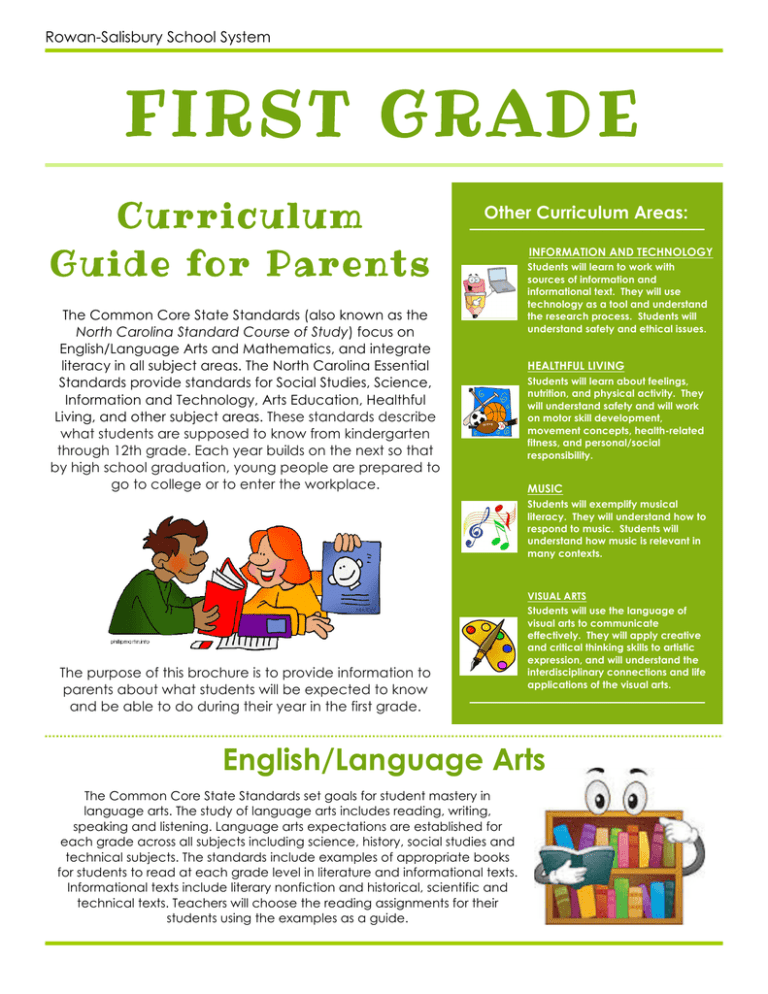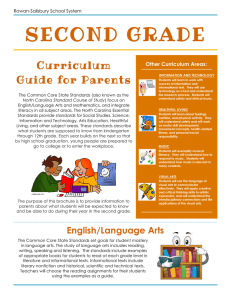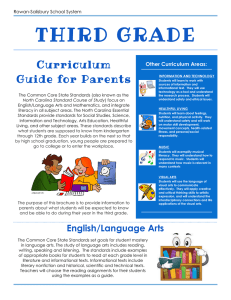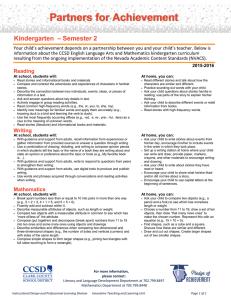FIRST GRADE Curriculum Guide for Parents
advertisement

Rowan-Salisbury School System FIRST GRADE Curriculum Guide for Parents Other Curriculum Areas: The Common Core State Standards (also known as the North Carolina Standard Course of Study) focus on English/Language Arts and Mathematics, and integrate literacy in all subject areas. The North Carolina Essential Standards provide standards for Social Studies, Science, Information and Technology, Arts Education, Healthful Living, and other subject areas. These standards describe what students are supposed to know from kindergarten through 12th grade. Each year builds on the next so that by high school graduation, young people are prepared to go to college or to enter the workplace. INFORMATION AND TECHNOLOGY Students will learn to work with sources of information and informational text. They will use technology as a tool and understand the research process. Students will understand safety and ethical issues. HEALTHFUL LIVING Students will learn about feelings, nutrition, and physical activity. They will understand safety and will work on motor skill development, movement concepts, health-related fitness, and personal/social responsibility. MUSIC Students will exemplify musical literacy. They will understand how to respond to music. Students will understand how music is relevant in many contexts. The purpose of this brochure is to provide information to parents about what students will be expected to know and be able to do during their year in the first grade. VISUAL ARTS Students will use the language of visual arts to communicate effectively. They will apply creative and critical thinking skills to artistic expression, and will understand the interdisciplinary connections and life applications of the visual arts. English/Language Arts The Common Core State Standards set goals for student mastery in language arts. The study of language arts includes reading, writing, speaking and listening. Language arts expectations are established for each grade across all subjects including science, history, social studies and technical subjects. The standards include examples of appropriate books for students to read at each grade level in literature and informational texts. Informational texts include literary nonfiction and historical, scientific and technical texts. Teachers will choose the reading assignments for their students using the examples as a guide. 1 2 3 Rowan-Salisbury School System English/Language Arts Reading: Literature Students will ask and answer questions about key details in a text and retell stories. They will describe characters, settings, and major events in a story, using key details. They will explain major differences between books that tell stories and books that give information. They will use illustrations and details in a story to describe its characters, setting, or events. With help, students will read prose and poetry appropriate for first graders. They will decode regularly spelled one-syllable words and two-syllable words following basic patterns. Students will recognize and read gradeappropriate irregularly spelled words. They will read with sufficient accuracy and fluency to support comprehension. Reading: Informational Text Students will ask and answer questions about key details in a text and identify the main topic and retell key details of a text. They will ask and answer questions to help determine or clarify the meaning of words and phrases in a text. They will use various text features (e.g., headings, tables of contents, glossaries) to locate key facts or information in a text. They will use the illustrations and details in a text to describe its key ideas. With help, students will read informational texts appropriate for first graders. Reading: Foundational Skills Students will demonstrate understanding of the organization and basic features of print. They will recognize the distinguishing features of a sentence (e.g., first word, capitalization, ending punctuation). Students in grade one will demonstrate an understanding of spoken words, syllables, and sounds. They will know and apply grade-level phonics and word analysis skills in decoding words. 2 strengthen writing as needed. They will also use a variety of digital tools to produce and publish writing and participate in shared research projects. Speaking and Listening Students will participate in collaborative conversations about texts with peers and adults in small and large groups. They will describe people, places, things, and events with relevant details, expressing ideas and feelings clearly. Students will add drawings or other visual displays to descriptions. Language Writing Students will learn to write opinion pieces in which they introduce the topic or name the book they are writing about, state an opinion, supply a reason for the opinion, and provide some sense of closure. They will write informative/explanatory texts in which they name a topic, supply some facts about the topic, and provide some sense of closure. They will write narratives in which they recount two or more appropriately sequenced events, include some details, use words to signal event order, and provide some sense of closure. With help from adults, students will focus on a topic, respond to questions and suggestions from peers, and add details to Students will demonstrate command of the conventions of standard English grammar and usage when writing or speaking (e.g., printing all upper-and lowercase letters, using nouns, pronouns, adjectives). They will demonstrate command of the conventions of standard English capitalization, punctuation, and spelling when writing. They will determine or clarify the meaning of unknown and multiple-meaning words and phrases, choosing flexibly from an array of strategies. Students will distinguish shades of meaning among verbs differing in manner (e.g., look, peek, glance, stare, glare, scowl) and adjectives differing in intensity (e.g., large, gigantic) by defining or choosing them or by acting out the meanings. 1 3 2 Elementary Education Department Reading 3D Reading 3D is a two-part assessment that enables teachers to get a complete picture of each child’s ability to read with comprehension. It combines quick indicators of foundational skills in reading through the DIBELS assessment along with a running record (TRC or text reading and comprehension) to better understand how students find meaning in the text they read. Given at the beginning of the year (BOY), middle of the year (MOY), and end of the year (EOY), the Reading 3D assessments help teachers monitor a student’s growth and progress in reading. Reports are sent home to parents after each assessment. The results of the Reading 3D assessments also allow teachers to personalize what students are taught in their guided reading groups and provide individualized instruction to students to enable them to become better readers. Mathematics The Common Core Mathematics Standards place an emphasis on eight mathematical practices. These practices are strategies for thinking through and solving mathematical problems. 1. Make sense of problems and persevere in solving them. 2. Reason abstractly and quantitatively. 3. Construct viable arguments and critique the reasoning of others. 4. Model with mathematics. 5. Use appropriate tools strategically. 6. Attend to precision. 7. Look for and make use of structure. 8. Look for and express regularity in repeated reasoning. Based on these practices, first graders will learn: Number and Operations in Base Ten First graders will learn to count to 120, starting at any number less than 120. They will understand place value and use place value understanding and properties of operations to add and subtract. They will add within 100 and subtract multiples of 10 in the range 10-90 from multiples of 10 in the range 10-90 (positive or zero differences), using concrete models or drawings and strategies based on place value, properties of operations, and/or the relationship between addition and subtraction. Operations and Algebraic Thinking Students will learn to represent and solve problems involving addition and subtraction. They will understand and apply properties of operations and the relationship between addition and subtraction. Students will add and subtract within 20. Students will work with addition and subtraction equations (i.e.: finding the unknown number that makes the equation true in each of the equations: 8+ ? = 11 5= ? –3 6+6= ? Measurement and Data Students will measure lengths. They will tell and write time in hours and half-hours using analog and digital clocks. Students will represent and interpret data with up to three categories. Geometry Students will work with shapes and their attributes. They will compose two-dimensional shapes (i.e.: rectangles, squares, trapezoids, triangles) or threedimensional shapes (i.e.: cubes, rectangular prisms, circular cones) to create a composite shape, and compose new shapes from the composite shape. Students will divide circles and rectangles into two and four equal shares, and describe the shares using the words halves, fourths, and quarters. 3 1 2 Rowan-Salisbury School System Science By the end of first grade, students should be able to conduct investigations, gather evidence, and grow in their understanding in the following areas: Forces and Motion Students will understand how forces affect the motion of an object. They will explain how some forces can be used to make things move without touching them, such as magnets. Students will predict the effect of a given force on the motion of an object, including balanced forces. Earth Systems, Structures and Processes Students will understand the physical properties of materials that make them useful in different ways. They will compare the properties of soil samples from different places relating their capacity to retain water, nourish and support the growth of certain plants and will summarize the needs of living organisms. Ecosystems Students will understand characteristics of various environments and behaviors of humans that enable plants and animals to survive. They will recognize that plants and animals need air, water, light, space, food and shelter and that these may be found in their environment. Earth in the Universe Students will recognize the features and patterns of the earth/moon/sun system. They will recognize differences in the features of the day and night sky and movement of objects across the sky as observed from Earth. Students will recognize changes in the moon’s appearance from day to day. Social Studies First grade students are introduced to Social Studies by exploring aspects of self, others, families, and communities across the world. They will focus on development of awareness to the similarities among individuals in the classroom as well as within the school, community and world. History Students will understand that history tells a story of how people and events changed society over time. They will explain why national holidays are celebrated. Civics and Governance Students will understand the importance of rules. They will classify the roles of authority figures in the home, school and community. They will be able to summarize various ways in which conflicts could be resolved in homes, schools, classrooms, and communities. Geography and Environmental Literacy Students will use geographic tools to identify characteristics of various landforms and bodies of water, and will understand how humans and the environment interact within the local community. Economics and Financial Literacy Students will understand basic economic concepts, will identify examples of goods and services in the home, school, and community, and how supply and demand affects the choices families and communities make. Culture Students will understand the diversity of people in the local community. They will compare the languages, traditions, and holidays of various cultures. Rowan-Salisbury School System ~ Elementary Education Department 314 N. Ellis Street, Salisbury NC 28145 PHONE: (704) 630-6105 WEB: www.rss.k12.nc.us TWITTER: @ELEM_rowan 4









